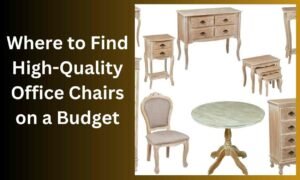Bunk beds are a practical and space-saving solution for many households, particularly those with children or those looking to maximize a small bedroom’s functionality. Choosing the perfect bunk bed requires careful consideration of various factors, including safety, design, and functionality. This article will guide you through the essential aspects of selecting a bunk bed that fits your home and meets your family’s needs.
1. Understanding Your Needs
Before diving into the world of bunk beds, take some time to assess your specific needs. Consider the following questions:
- Who will use the bunk bed? If it’s for children, consider their ages and whether they’ll need the upper bunk. If it’s for adults or guests, ensure the design is sturdy enough for adult use.
- How much space do you have? Measure the room’s dimensions, keeping in mind ceiling height, as bunk beds can be quite tall. Ensure there’s enough space for moving around, and consider other furniture that may be in the room.
- What is your budget? Bunk beds come in a wide range of prices, from budget-friendly options to high-end models. Establishing a budget can help narrow your choices.
2. Types of Bunk Beds
Bunk beds come in various styles and configurations to suit different needs. Here are some popular types:
Standard Bunk Bed
The classic design features two beds stacked on top of each other. This is ideal for saving floor space and is often used in children’s rooms.
Loft Bed
A loft bed features only the upper bunk, leaving the space beneath open for other uses. This can be used for a desk, play area, or additional storage.
L-Shaped Bunk Bed
This design consists of two beds arranged in an L-shape. This is a great option for larger rooms and can add visual interest while providing separate sleeping areas.
Triple Bunk Bed
For larger families or sleepovers, a triple bunk bed allows for three sleeping spaces stacked vertically. However, be sure to check the height and stability for safety.
Bunk Bed with a Slide
Ideal for younger children, these beds feature a slide that adds an element of fun to the sleeping arrangement.
3. Safety Considerations
Safety is paramount when choosing a bunk bed, especially for children. Here are key safety features to look for:
Guardrails
Ensure that the upper bunk has sturdy guardrails on all sides to prevent falls. The guardrails should be at least 5 inches higher than the mattress.
Sturdy Ladder
A stable ladder is essential for accessing the upper bunk. Make sure the ladder is securely attached and has non-slip steps for better grip.
Mattress Size
The mattress should fit snugly within the bed frame without gaps. This minimizes the risk of entrapment and ensures that the guardrails provide adequate protection.
Weight Limit
Check the manufacturer’s weight limit for each bunk. Ensure it accommodates the intended users, especially if adults may be using the bed.
Quality of Materials
Look for bunk beds made from durable materials, such as solid wood or metal. Avoid flimsy designs that could compromise safety.
4. Design and Style
The aesthetic of your bunk bed should complement your home’s decor. Here are some design elements to consider:
Material
Bunk beds come in various materials, including:
- Wood: Offers a classic look and durability. It can be painted or stained to match existing furniture.
- Metal: Provides a modern appearance and is typically lightweight. Metal frames can also be more affordable.
- Combination: Some beds combine wood and metal for a unique look.
Color and Finish
Choose a color that matches the room’s color scheme. Neutral colors can blend seamlessly, while bold colors can serve as a statement piece.
Customization Options
Some manufacturers offer customizable options, allowing you to choose finishes, styles, and additional features like built-in storage.
5. Functionality and Additional Features
Consider the additional features that can enhance the functionality of your bunk bed:
Storage Solutions
Many bunk beds come with built-in drawers, shelves, or desks underneath. This helps maximize space, particularly in smaller rooms.
Convertibility
Some bunk beds can convert into two separate beds, which can be beneficial if your needs change over time.
Accessories
Consider accessories like bedding, curtains, or decorative elements that can enhance the room’s style while providing comfort.
6. Measuring Your Space
Accurate measurements are crucial to ensure the bunk bed fits well in the designated area. Here’s how to measure effectively:
Room Dimensions
Measure the length, width, and height of the room. Pay special attention to ceiling height, as you want to ensure there is adequate headroom above the upper bunk.
Floor Space
Ensure there’s enough space around the bunk bed for easy access, particularly if you have other furniture in the room. Consider the need for space to make the bed and move around comfortably.
Doorways and Stairs
Consider the dimensions of doorways and staircases through which the bunk bed will need to pass. If it’s difficult to maneuver, it could pose a problem during delivery.
7. Assembly and Maintenance
Most bunk beds require assembly upon delivery. Here are some tips for assembly and maintenance:
Easy Assembly
Choose a bunk bed that comes with clear instructions and all necessary tools. Some brands offer beds that are easier to assemble than others.
Regular Maintenance
Inspect the bunk bed regularly for loose screws or parts. Tighten them as needed to ensure safety and longevity.
Cleaning
Consider how easy it is to clean the bunk bed. Choose materials that are easy to wipe down and maintain, especially if the bed will be used by children.
8. Popular Brands and Where to Buy
When choosing a bunk bed, consider reputable brands known for their quality and safety standards. Here are some popular options:
- Fatima Furniture Store: Known for affordable, stylish bunk beds with various designs.
- SAN Furniture: Offers sturdy wooden bunk beds with great safety features.
- Home Centre: Known for modern designs and eco-friendly materials.
- IKEA: Offers a range of customizable options at budget-friendly prices.
You can find bunk beds at various retailers, both online and in-store. Be sure to read reviews and check ratings to ensure you’re buying a quality product.
9. Conclusion
Choosing the perfect bunk bed for your home involves careful consideration of your needs, space, safety, style, and functionality. By following the guidelines outlined in this article, you can make an informed decision that meets your family’s requirements and enhances your home’s interior.
A well-chosen bunk bed can provide a practical solution for sleepovers, siblings sharing a room, or maximizing space in a guest room. Remember to prioritize safety and quality to ensure that your investment serves you well for years to come. Ultimately, a thoughtfully selected bunk bed can blend seamlessly with your other bedroom furniture, contributing to a stylish and functional living space.















